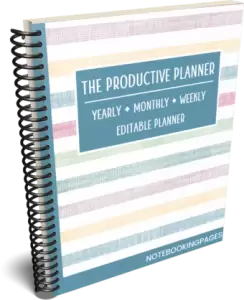Here are some suggestions on organizing your homeschool schedule if you are wondering, “How do I fit in all the subjects I need to complete each day and each week with my children?”
Here are some suggestions that worked for us that you may find helpful when playing around with your daily schedule to see what works best for you.
The first set of suggestions are for the elementary years and then some suggestions for tweeks to this as your children approach middle school years.
For over 50 workshops and free resources ($1200+) to help you in creating a schedule that works for you and your family and start your new homeschool year off right you’ll want to get a FREE BASIC PASS to the 2025 Homeschool Super Heroes Online Conference.
Scheduling the Elementary School Homeschool Years
Which Subjects Do You Have to Work on Individually with Each Child?
When trying to work out a schedule to cover specific subject areas, determine which subjects you can work with groups of your children together at one time and which ones require you to give individual attention to your children at each of their ability level.
Because of a three year age gap, my guys were at different math, reading, spelling, writing, and vocabulary levels.
I would assign my older guy some reading time alone while I worked on reading skills and phonics with my younger guy (phonics since that is the method which seemed to work best with him).
Then I would give my younger son a little activity to do that he could do on his own while introduced or reviewed a math concept with my older guy.
After doing some practice problems together and a couple on his own to make sure he had the right idea, I would give him practice problems to work on independently while I worked on math with my younger one.
We were always in the same room on the floor or at the kitchen table so I could eyeball what each child was doing.
While my younger was working on a couple of math problems at a time on his own or some kind of math related activity (depending on his age), I would read aloud spelling words for my older one to practice writing down.
If I needed more time to work on something with my younger son, my older might work with a spelling or vocabulary activity.
Our morning time would be spent like this on daily basis to make sure we covered the basics.
If I had more than two and they were closer together, I would group them together in these subjects according to their abilities.
As it turned out with my guys and their age differences, they were always in different math courses with me but by the time the younger was a senior in high school, they were both taking a Precalculus course in college because of their different skills and ability levels.
So, as your children grow older, you will notice that age differences do not begin matter as much, and their abilities and skill levels in different subject areas may not be as distinct as they were in the early grades.
To keep track of lesson plans for each day and for a list of assignments to hand each of my children, I developed a Homeschool Student Daily Plan Checklist. (It is free for you to download when you click on this link.)
I would write out a day’s or week’s worth of assignments on these sheets depending on how my time was or how our week was going.
I would hand this sheet to each of my sons with their assignments for the day written out for them to follow.
Some of the work we did together and some they worked on independently, as described above.
When they completed each assignment, they would check it off on the Homeschool Student Student Daily Plan Checklist.
I would retrieve the sheets back from them at the end of the day, 3 – hole punch them and put them in a 3- ring binder to keep for our homeschool records, as required by our state’s law.
Any assignments that were not completed for some reason would be added to the sheet for the next day.
Which Subjects Can We all Do Together?
Other subject areas such as history, science, beginning foreign language, art or music were studied together as a family.
History was studied through the use of “living books” read aloud in a unit study type format.
(Read Our Homeschool Version of a Middle Ages Unit Study to see how we did this together.)
As you will see if you read how we did our unit studies, oral and written narration were done together as part of our historical unit study and I was able to assist them at the same time as they practiced their writing skills.
Sometimes those unit studies included our other subject areas like science, art or music, when it could be added naturally to our unit.
Other times we picked areas of science (like nature study) or art or music in which to pursue activities that we felt like doing at the time.
(My nature study books give you detailed steps as to how we conducted nature studies according to the seasons and what science we encountered outside.)
These subject areas were not done every day, but were done in the later morning, lunch, or early afternoon hours.
We might do something with history three times that week and science the other two days, depending on projects, experiments, or field trip opportunities we were involved in that week.
Other times it was history twice and science three times.
The other areas like art, music or foreign language would also be worked in once or twice per week depending upon what we were doing or working on that week in science or history.
When I made out our schedule, I would pencil in which subjects would be covered each week but would remain flexible in either adding another day or subtracting and substituting another due to being in the middle of a project or experiment taking longer than anticipated.
The idea for the foreign language, art, and music was to expose my guys to these, not to establish mastery in any of these subjects, so we didn’t stress about how many hours per week we spent on these.
In traditional schools, students may have 40 minutes every 5-8 days per subject.
Scheduling the Middle School Homeschool Years
As your children approach middle school years, there will be more independent learning time, giving you more time to work individually with younger children.
I still had my middle schoolers follow the same schedule as the rest of the family with the core subjects every day in the morning hours.
I would make sure to spend more individual time with my middle schooler on paragraph and short essay writing structure and other skills needed to prepare him for his coming years in high school, while my younger worked on his own for bits of time in the morning.
The other subject areas were still done together as a family after the core subjects in the morning.
I took a relaxed approach during the middle school, knowing that high school would be more independent and more intense work with not as much family time studying together.
To read about how we scheduled high school in our homeschool, read How to Schedule Your Homeschool High School Years.
Organizing Family Time and Outside Commitments
Organizing family time, commitments, and school time is more of a challenge.
The first step is to examine where your time has been going the past school year and reassess time spent.
If you feel the need for more of a structured schedule and unschooling or relaxed schooling is not for you, determine what hours you will hold “school” and stick to it, most days.
Then determine how much time on what days you will study which subjects. Then work the rest of your schedule around and after that.
Look at what extracurricular, volunteer, and church activities each family member participates in and have each person determine their top one or two activities that are most important to them.
Only actively participating in those full time activities will allow more relaxation time for everyone and less stress about completing school time.
Another option is to have one full time activity for the year, and choose various seasonal activities or activities that only occur once or twice per month to fill in here and there to add a second activity.
This allows for a more balanced schedule and not a continuous hectic “always running around” kind of routine.
Hanging a full size “mommy planning calendar” with lines and large spaces for each family member’s name and activities keeps everyone organized.
These calendars usually have a pocket on the back flap to store important papers such as permission or registration slips, or activity schedules and information, always at your fingertips.
Heavy duty metal clips with a magnet on the back makes these calendars easy to hang on the side of the refrigerator out of direct sight.
An alternative to this is a desk calendar with larger boxes to write in with perforated pages you can tear off at the end of the month.
Saving these pages and the pages from the calendar makes a great record keeping system to record your kids’ activities and various health appointments for those transcripts, homeschool records, and annual appointment keeping.
Once school and activities are scheduled on paper, how do you homeschool and keep up with the house?
One idea to manage your grocery list and avoid repetitive trips to the store is to keep a magnetized pad of paper on the refrigerator with a handy pen to write down items you notice are needed or running low.
When it comes time to go shopping, writing your list will mostly be completed.
Designate times in the day for the kids to do an independent activity where you can complete a quick chore.
One quick chore each school day makes a big dent in keeping up with the chores.
Creative multitasking is the key.
Fold laundry while your child reads aloud to you or while you orally quiz them on spelling words.
If your child needs to read a chapter of a book or do a math sheet on his own, you can quickly clean up the kitchen or do one bathroom.
Assign yourself a certain task for each day of the week to correspond with an activity your child will do for school work that day.
Of course, assigning chores to the kids is always a good idea as well.
(Read How do you Motivate your Kids to Complete Chores and Homeschool Assignments? if you need ideas in getting chores done during the homeschool day.)
At the end of each activity, have your child immediately return that material to its “assigned home” in your homeschool space to eliminate clutter build up during the day.
Otherwise at the end of your school day, have a clean up 5 minute window to put away everything used during the day before any other “free time” is allowed.
Some homeschoolers prefer “block scheduling” for subjects per day.
Study a number of hours on specific days a specific subject (you decide which days, how much time, and which subject).
Others prefer studying every subject every day for bits of time.
We found that the basics we needed to cover like math or spelling that needed repetition and practice in smaller increments worked best for us every day.
Subjects like literature, science, history, art, etc were a little bit larger blocks of time (great for allowing enough time for projects and experiments) a couple of times per week worked best.
Reading was an every day activity whether it was a chapter or two together read aloud, or free reading time for each child to do on his own during a quiet time “for mom.”
I have a daily checklist for you or your child to complete for each subject you have planned for that day.
These forms can serve as your daily lesson plan sheet when planning for the week (which is how I used them) and a check off sheet to help your children become accountable for assignments completed (which they will be responsible for during the high school years and another form I have created for them here at How to Schedule your Homeschool High School Years.)
Elementary and Middle School Daily Plan Checklist
For some scheduling ideas and forms to assist you in your organization, take a look at the following website
- Productive Planner (aff)
If you have any time organizing tips in balancing schedule and home life, please share them with us!







